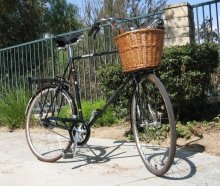I hope Amy Walker will not mind my saying so, but the book she recently edited, On Bicycles, 50 Ways the New Bike Culture Can ChangeYour Life, may be the perfect bathroom reader for bicycle riders. The book is made up of fifty short essays on various aspects of bicycles, bicycle advocacy and bicycle infrastructure. Walker was one of the founders of Momentum, a magazine devoted to promoting practical bicycling. In creating her book, she used the network of writers she developed during her time at Momentum to collect a diverse group of articles from different authors, all of whom are real-world bicycle enthusiasts. The result is a book made up of quick, easy-to-digest articles that are perfect for those times when a reader has a few minutes to sit and relax.
A few of the essays were especially enjoyable:
-
“Because
It’s Fun,” by Terry Lowe, is a wonderful descriptions of the reasons why riding
a bicycle makes you feel like a kid again.
When bicycle riding is approached from the proper perspective, it gives
the rider a thrilling sense of elation as the bicycle becomes an extension of
the rider’s body.
-
“A Rough Guide to the City Bike,” by Wendell
Challenger provides a simple, practical overview of the benefits of modern city
bicycles, as well as a guide to setting them up to be safe, reliable and
useful.
-
“E-bikes offer an Extra Push,” by Sarah
Ripplinger, offers an introduction to electric bicycles without any of the
snobbery that some cyclists show toward electric bicycles.
-
“A History of Bike Advocacy,” by Jeff Mapes,
chronicles the tireless efforts of many people and organizations that have advocated
for bicyclists’ rights over the years.
 |
| Amy Walker |
There are many other great pieces in the book as well. Different readers will be compelled by
different articles, and the short essay format is great because it allows
readers to skip the essays that do not interest them. Also, when a reader reaches “bicycle advocacy
overload,” he/she can ignore the book for weeks on end, until he/she is ready
to absorb more bicycle information.
There were a few times when articles made statements that
rubbed me the wrong way. In her piece,
“Women and the Benefit of Biking,” Elly Blue may be technically correct when
she writes, “Even in households where both a male and a female partner work
full-time, child care and unpaid labor like running errands, cooking and
cleaning tend to fall to the woman.”
However, when such language is read by a father who has always been the
primary caregiver to his children and has always made sure to be a full partner
in the “unpaid labor” aspects of his relationships, he tends to feel alienated
and unappreciated.
John Pucher’s article, “Cycling Rights-of-Way” is, generally
speaking, informative and worth reading.
However, I must respectfully disagree with contention that separate
bicycle paths are of primary importance for “safe and stress-free
cycling.” Don’t get me wrong, I am a fan
of bike paths and I usually use them when they are available. However, multiple studies (e.g. Clarke &
Tracy, 1995, p. 85; Williams & McLaughlin, 1992, p. 7) have concluded that
cyclists on separated bicycle paths are more likely to be seriously injured
than those riding in bicycle lanes painted onto roadways. While inexperienced riders may feel safer on
separated bicycle path, such feelings could be alleviated by educational
campaigns demonstrating the safety benefits of integrated bicycle lanes.
Nitpicking aside, On Bicycles is a great book. I would recommend it to anyone from a novice
rider who just picked up an old Schwinn Varsity at a garage sale, to a seasoned
bicycle advocate with decades of experience, and everyone in between. If you are excited about using your bicycle
for transportation, you will find many essays in On Bicycles that
inspire you and increase your passion for bikes.




